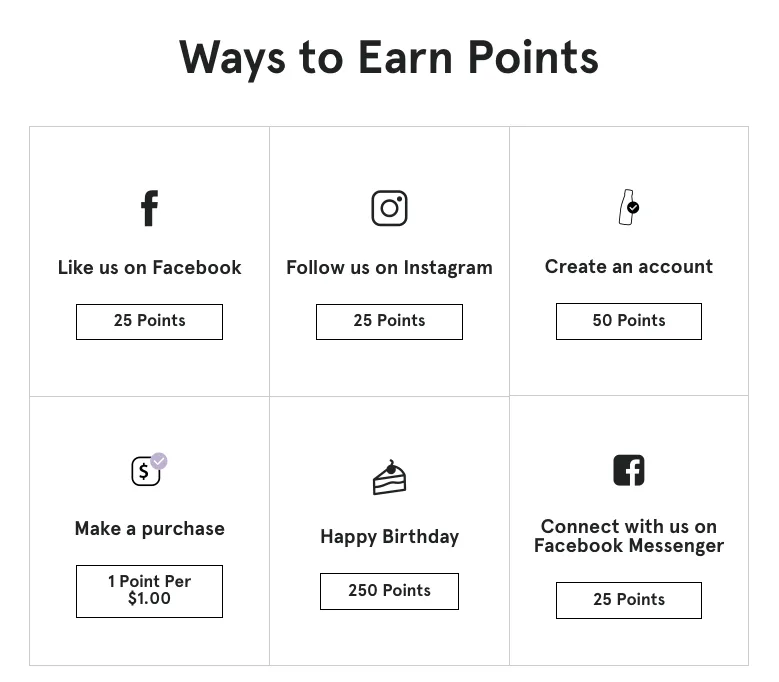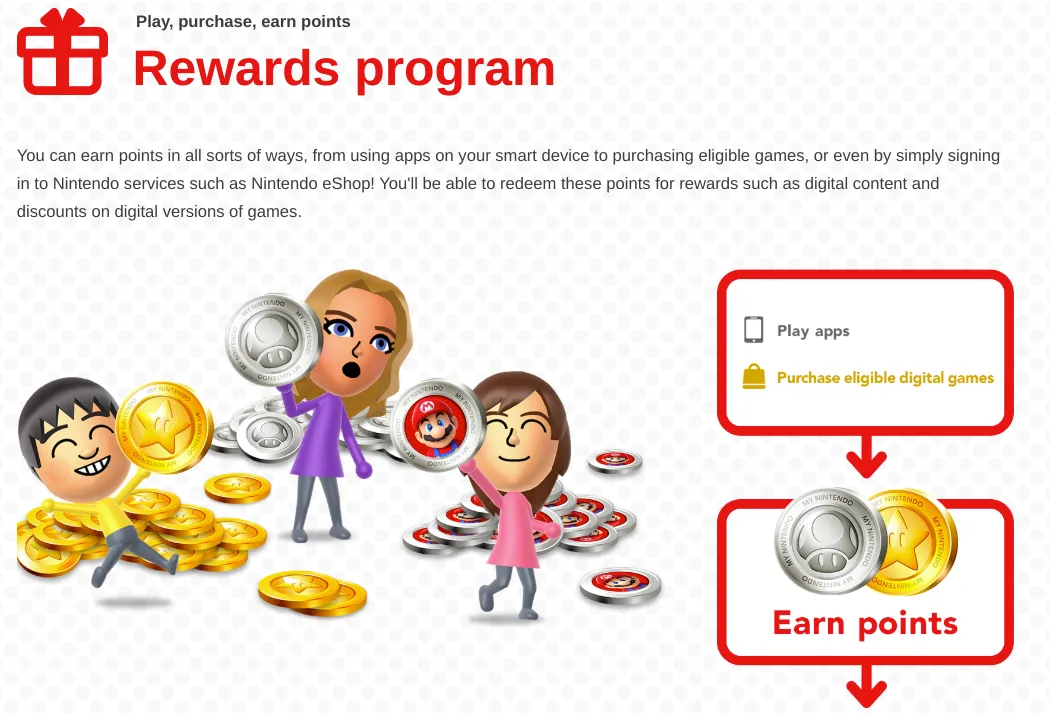Loyalty Points: The Traditional Reward for Modern Growth
Loyalty points have been around since the inception of rewards programs.
Many of us are familiar with the concept of collecting points when filling up on groceries or booking a flight. We’re used to carrying around cards to be used at our next visit to the coffee shop or car wash, in an effort to reach a prize goal.
While traditional points programs often require businesses to wait until customers walk through the door, digital businesses can take advantage of loyalty points when customers are engaged through mobile apps and computers at all times of the day.
For example, customers can earn points for downloading an app, filling out their profile, watching a video, logging in 10 times per month, taking a survey, or inviting friends to your brand. Points can be collected and redeemed virtually with no need to make a trip in-store.
As a digital business, you can still leverage all the benefits of loyalty points but in ways that traditional businesses never could.
Plus, setting up a loyalty points program with a customizable platform like SaaSquatch means you can:
- Encourage valuable customer behavior by creating formulas that determine exactly how many points are awarded for each type of action, and
- Engage customers across the entire lifecycle by stacking multiple triggers that give people different point amounts for different kinds of actions.
Keep reading to learn the benefits of starting a points program, what it looks like, and how we can help you make it work for your business.
Why start a loyalty points program?
The goal of any loyalty program is to keep customers engaging with your brand in profitable ways. This can mean making more purchases, or simply keeping their subscriptions active.
When users are rewarded with points for shopping and performing other profitable actions, the positive reinforcement turns these actions into a habit and gives them less of a reason to switch to a competitor.
Points are one of the most widely-used incentives in loyalty programs today, and are making their mark on digital loyalty programs given the increased flexibility of online interactions.
What is it about points that have helped them withstand the test of time and still be used today?
A buildup of points increases switching costs
A customer is less likely to leave your brand for a competitor when switching means giving up their points balance. This is where we see a customer’s innate aversion to loss come into play.
We’re wired to avoid loss and the negative feelings that come with it, which means that the risk of losing progress towards the next points milestone will discourage customers from willingly switching between competing brands.
Keeps reward spending within your brand
To spend points, users typically need to return to your website or app to redeem for a purchase or other reward. When both the collection and redemption of points mean interacting with your brand again, you increase the frequency of customer engagement, boosting each customer’s lifetime value and the potential for referrals
Encourages increased spending and upsells
Using goals and tiers within your points program is a great way to increase the value of every purchase and action with gamification. When someone can see that they’re close to reaching a goal, they are more motivated to achieve it.
So if a customer needs to make one more purchase this month or add $10 more to an order to collect enough points for the next reward tier, their motivation will be much higher than if there was no added benefit.
Points can be worth anything you want
The best part about loyalty points in the digital space is that they can mean something different for every business. One point earned with your business can have a completely different meaning than one point earned through a competitor, and can be redeemed in your own unique way.
For example, your points might:
- Grant customers access to a membership level with unique benefits like free shipping and early access to discounts,
- Let customers upgrade to a premium membership plan with better features, or
- Let customers trade them for items from a catalogue.
What does a digital loyalty points program look like?
While many of us are used to carrying around physical cards to collect points, digital points programs can reward many more actions and with much more flexibility.
Here are a few examples of points programs today:
Soylent Rewards
Soylent is a brand of meal replacement products sold online. Customers are presented with multiple ways to earn points, such as by making a purchase (1 point for every $1 spent), engaging with the brand on social media, and creating a more detailed profile.
Users can trade in points for discount coupons to use on their next order.

Why it works: As an e-commerce platform, Soylent benefits from frequent purchases from every customer. Points must be put towards future purchases, which encourages more spending.
Notice how Soylent places a high value of points for actions like entering a birthday and filling out a profile. This information is useful for running re-engagement campaigns and personalized offers, which in turn increases revenue and loyalty.
Nintendo My Rewards
Nintendo’s My Rewards lets users earn points by making purchases, playing with friends, or completing missions in various games. Points can be redeemed for rewards like exclusive games, discounts, in-app items, or put towards purchases on the Nintendo store.

Why it works: As a video game company, Nintendo’s business model relies on increased and continual platform usage. Their points programs rewards both by driving purchases and increasing play time.
By rewarding users for completing specific in-game actions and inviting friends to play with, they’re able to boost engagement and expand the network of loyal Nintendo users.
Care/of
Care/of is a subscription service that delivers customized daily vitamin packs. Their loyalty program lets customers earn points (“Carrot Rewards”) by referring friends and using the mobile app to record taking vitamins each day.
Carrot rewards can be redeemed in the Care/of Market for branded merchandise, dollar credit, and even an Apple watch or Peloton bike.

Why it works: As a monthly subscription service, Care/of needs to focus on encouraging customers to keep their recurring payment active.
By rewarding users for something as simple as taking their vitamins, customers are happy to receive a bonus, while the company ensures each user will be regularly in need of next month’s subscription.
How to start a loyalty points program with SaaSquatch
Step 1: Decide when points can be earned
Decide for how long users can earn points through your program. Setting a specific date range is great for running limited-time offers for bonus point collection as a way to create urgency.
Point collection timeframes are also used in status level programs where a customer must earn the qualifying amount of points within a specific year in order to achieve status for next year.

Step 2: Decide how points are earned
How will customers collect points, and how many points will they earn as a result?

Choose when to reward customers:
- Will customers earn points for making a purchase, filling out their profile, downloading an app, or other action?
- For each action, add conditions like what kind of item must be purchased, what amount must be spent or what segments qualify.
Choose how many points they will earn:
- When a purchase or other custom event is completed, how many points are earned as a result?
- Set up anything from a simple structure where $1 spent = 1 point, or enter your own custom formula. For example, let customers earn 5 points for every increment of $10 spent, 100 point bonus for every year they’ve been a subscriber, or 20 points for every 5 star rating and 10 points for every other rating.
Combine criteria and conditions for both of these settings to create a flexible points program that rewards the customer behavior that is most valuable to your business. Got an idea? Talk to us about it!
Tip: Give customers multiple ways to earn points
If it makes sense for your business, keep adding different event triggers to specify how users can earn different amounts of points, and reward the most valuable customer actions with higher amounts of points.
For example, online retailer Simply Scuba encourages customers to leave reviews of scuba products purchased through their website. The more detailed a review (ie. by adding a picture or video), the more points are earned.

Tip: Make points redeemable at regular intervals
The most common issue with points-based loyalty programs is a lack of immediate gratification. When customers are expected to collect points over time before earning a reward, they aren’t receiving a tangible reward after every purchase. In fact, 53% of consumers said it takes too long to earn a reward from their loyalty program.
Just like your company strives to achieve a positive ROI on your loyalty program, so do your customers. Make sure that customers are able to redeem their points for a reward of value after a realistic number of purchases or other actions.
Step 3: Set up reward delays and cancellation conditions (optional)
Setting up a delay period for giving out rewards is helpful if your users have a window (ie. 30 days) to return their purchase or cancel their free trial, in which case they shouldn’t earn any points if their purchase is refunded.

Another option is to set up reward retractions conditions so that a product return or trial cancellation will cancel any points that were earned as a result of the purchase.
Step 4: Set up an expiry on points (optional)
Setting up expiry conditions on rewards can be a great way to promote urgency while also reducing any financial liability, so that points are actually spent and not hoarded indefinitely. Since spending points usually means re-engaging with your brand, it’s in your best interest to encourage point redemption.
Be sure to clearly communicate any expiry conditions to your customers.

Tip: Keep customers informed with how many points they can redeem
According to Bond Loyalty, customers who actually redeem their rewards are twice as satisfied with their loyalty programs as non-redeemers. Encourage customers to redeem points by providing clear information on how and when to redeem.
Don’t expect customers to keep track of their own point balances. Let them quickly access balance and expiry information on your website or app.

Finish setting up your loyalty points program by designing your communications to notify your members when rewards are earned. To learn how to promote your loyalty once it’s launched, check out this article.